

Store Garden Produce -Series 1-10 Holistic Herbs. Time-Table For Blanching & Sterilizing The following time-table shows blanching time for various vegetables and fruits, as well as the sterilizing time in the hot-water bath outfit, and in equipment for sterilization by the water-seal method, the steam-pressure method and the aluminum steam-cooker method.
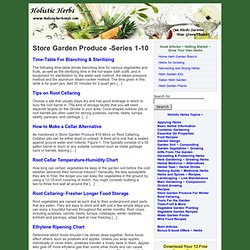
Cave Root Cellar. Our neighbor, Frank Hoyt Taylor, took advantage of the backhoe rented by a friend for grading a house site to dig a root cellar into his north-facing hillside.
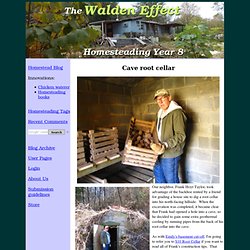
When the excavation was completed, it became clear that Frank had opened a hole into a cave, so he decided to gain some extra geothermal cooling by running pipes from the back of his root cellar into the cave. As with Emily's basement cut-off, I'm going to refer you to $10 Root Cellar if you want to read all of Frank's construction tips. That way, I'll have room in this post to sum up his results. The weakest link in Frank's root cellar is the front wall and door, both of which are open to the elements (although insulated with foamboard). Ice does occasionally form on the inside of the exposed front wall, but temperatures in the main root cellar stay steady for most of the year between 50 and 55 degrees. Building Plastic Barrel Root Cellar – Video. Root Cellars for Food Storage - Prepping Food Storage. Root Cellar Basics. Earthbag Building: Free Rootcellar Plan. Big Root Cellar Resource. There are various types of Root Cellars including ones connected and those separate from your home.
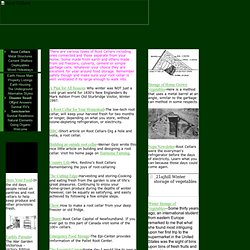
Some made from earth and others made from old freezers, culverts, cement or simple garbage cans. Whatever your choice they are excellent for year around food storage. Remember safety though and make sure your root cellar is well ventilated if its large enough to walk into. A Plan for All Seasons Why winter was NOT just a cold gruel world for 1830's New Englanders By Mark Ashton From Old Sturbridge Visitor, Winter 1997. Root Cellar. We decided that our little farm needed a root cellar to store our produce in.
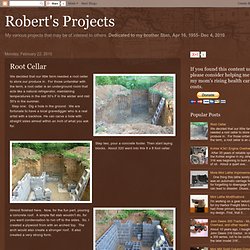
For those unfamiliar with the term, a root cellar is an underground room that acts like a natural refrigerator, maintaining temperatures in the mid 30's F in the winter and mid 50's in the summer. Step one: Dig a hole in the ground. We are fortunate to have a local gravedigger who is a real artist with a backhoe. He can carve a hole with straight sides almost within an inch of what you ask for. Step two, pour a concrete footer. Almost finished here. I built the form in the shop, then dismantled it. Satisfied with the form I reassembled it on the root cellar walls. A nice snug fit, supported by 3 vertical 2x4's on each side. 18 half inch rebars on 8 inch centers.
How To Build A Root Cellar - Part 1. The year round availability of fresh produce at supermarkets in this modern society has pretty much eliminated the use of the historic age-old root cellars.

It appears that all that remains of its existence are the fond childhood memories of that deep dark scary place known only to a kid as a fort! However, as more people are reverting back to the basics of home gardening, there is a revitalization of the good old-fashioned root cellar. It has been reborn into an indispensable addition. Best Fruits To Store - Root Cellaring. There are only two fruits that will store in a root cellar over winter without being processed — apples and pears.
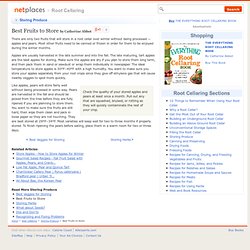
Most other fruits need to be canned or frozen in order for them to be enjoyed during the winter months. Apples are usually harvested in the late summer and into the fall. The late maturing, tart apples are the best apples for storing. Make sure the apples are dry if you plan to store them long term, and then pack them in sand or sawdust or wrap them individually in newspaper.
The ideal temperature to store apples is 30ºF–40ºF with a high humidity. Check the quality of your stored apples and pears at least once a month. Like apples, pears will store fairly well without being processed in some way. ! Root Cellaring- With Types of Produce & Storage Times. Best Veggies For Storing - Root Cellaring. All vegetables have different storage characteristics.
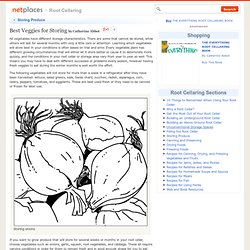
There are some that cannot be stored, while others will last for several months with only a little care or attention. Learning which vegetables will store best in your conditions is often based on trial and error. Every vegetable plant has different growing circumstances that will either let it store better or cause it to deteriorate more quickly, and the conditions in your root cellar or storage area vary from year to year as well.
This means you may have to deal with different successes or problems every season, however having fresh veggies to eat during the winter months is well worth the effort. The following vegetables will not store for more than a week in a refrigerator after they have been harvested: lettuce, salad greens, kale, Swiss chard, zucchini, radish, asparagus, corn, celery, peppers, tomatoes, and eggplants. Root crops include beets, carrots, Jerusalem artichokes, parsnips, rutabaga, turnips, and potatoes. 4 simple DIY root cellar ideas! The biggest challenge, at least for me, with gardening is preserving the harvest.
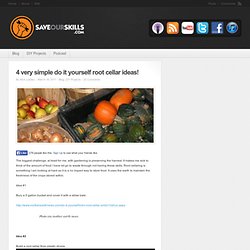
It makes me sick to think of the amount of food I have let go to waste through not having these skills. Root cellaring is something I am looking at hard as it is a no impact way to store food. It uses the earth to maintain the freshness of the crops stored within. Idea #1 Bury a 5 gallon bucket and cover it with a straw bale. Photo via mother earth news Idea #2.